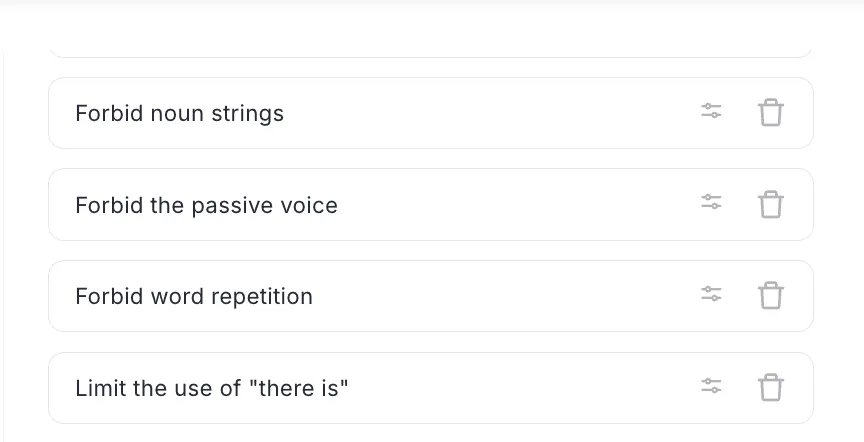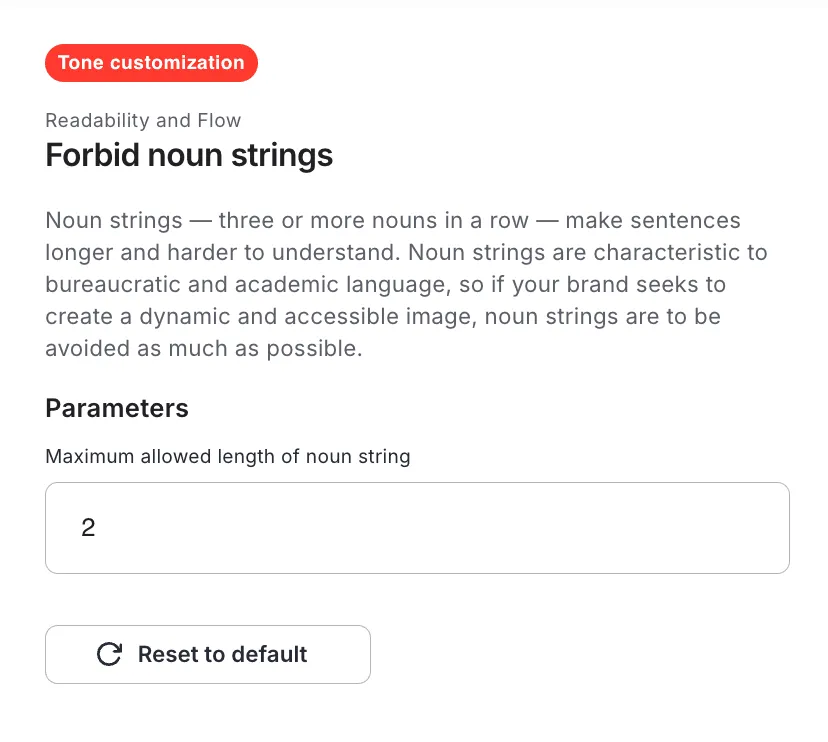Having written thousands of texts, there are general tips that you know just work. I’m not talking about custom tone of voice of a brand here.
These are 15 things that will improve your brand copy, regardless of its tone and character.
- Forbid the passive voice
- Adjust the ratio of verbs to nouns and adjectives
- Minimize the use of pronouns
- Require more action verbs and fewer “be” verbs
- Minimize the use of transition words
- Limit the use of “there is” and “there are”
- Minimize the use of prepositions
- Limit the use of adverbs
- Limit the use of acronyms
- Forbid acronyms without explanation
- Spell out numbers
- Spell out ordinal numbers
- Forbid abbreviated forms of months and days of the week
- Use a comma after the day of the week in dates
- Forbid noun strings
Now, let’s look at all of these in detail and see through numerous examples how you can raise the quality of your corporate texts.
Forbid the Passive Voice
It’s as simple as that — whenever possible, opt for active voice.
It improves sentence structure, makes your brand sound more confident, and creates more direct connections with your audience.
Passive voice can still be useful in certain cases, such as when the action is more important than the subject, but in general, it’s less effective in marketing copy. It weakens the impact of your sentences by making them indirect.
Active voice creates stronger, more engaging copy that clearly shows who is performing the action.
Before: “The new product was released by our team last week.”
After: “Our team released the new product last week.”
In the active version, the subject is clear, and the sentence flows more naturally.
Adjust the Ratio of Verbs to Nouns and Adjectives
Sentences loaded with nouns and adjectives can feel overly descriptive and slow.
Rephrasing your text so that it relies on verbs, not nouns and adjectives to convey the meaning, makes your copy more dynamic and action-oriented, encouraging readers to engage.
Before: “Our innovative product offers superior quality and remarkable durability.”
After: “Our product delivers quality and lasts longer.”
In the second version, “delivers” and “lasts” are action verbs, making the sentence more direct and powerful.
Minimize the Use of Pronouns
Overuse of pronouns like “it” and “they” can make sentences vague and harder to follow. By minimizing pronouns, you can make your copy clearer and more specific.
Before: “Our product is amazing. It helps customers save time and money.”
After: “Our product helps customers save time and money.”
Removing unnecessary pronouns simplifies the sentence without sacrificing meaning.
Require More Action Verbs and Fewer “Be” Verbs
“Be” verbs (am, is, are, was, were, being, been) make sentences weaker by focusing on states of being rather than actions.
Action verbs drive the message forward and make the copy more dynamic, persuasive and engaging.
Before: “Our software is designed to streamline business processes.”
After: “Our software streamlines business processes.”
The second sentence is more concise and dynamic, thanks to the use of the action verb “streamlines.”
We have written a separate blog post on the impact of verbs on brand tone of voice where we look at the research on this topic as well.
Minimize the Use of Transition Words
While transition words (e.g., “however,” “therefore,” “thus”) can help with flow, overusing them can clutter your writing.
Keeping your sentences short and direct often eliminates the need for them.
Before: “Our product is affordable. However, it also delivers premium quality.”
After: “Our product is affordable and delivers premium quality.”
The removal of “however” makes the sentence smoother and more concise. It also removes the air of uncertainty and lack of confidence.
Read more on other practices that will help you build an assertive and self-confident brand tone.
Limit the Use of “There is” and “There are”
Sentences that start with “there is” or “there are” can feel unnecessarily wordy and impersonal.
Often, these constructions add extra words without enhancing meaning.
Try to rewrite sentences to avoid starting with “there is” or “there are.” This will make your writing tighter and more energetic.
Before: “There are many features that make our software stand out.”
After: “Many features make our software stand out.”
The second version is shorter, more engaging, and retains the same meaning.

Minimize the Use of Prepositions
Prepositions (e.g., of, to, from, with) often lead to longer, more convoluted sentences. Reducing their use makes your copy more straightforward and concise.
Before: “The implementation of the new system resulted in an improvement in productivity.”
After: “The new system improved productivity.”
The second sentence is clearer and shorter by avoiding unnecessary prepositional phrases.
Limit the Use of Adverbs
Adverbs often weaken sentences by describing actions that should be self-evident. Using stronger verbs eliminates the need for most adverbs.
Before: “Our software works quickly and efficiently.”
After: “Our software delivers fast, efficient results.”
By using stronger nouns and verbs, the need for adverbs disappears, and the sentence becomes more impactful.
Limit the Use of Acronyms
Acronyms can confuse readers, especially if they aren’t familiar with them. Brand copy must be inclusive and easy to understand for all readers.
So especially if your audience is diverse, avoid acronyms unless absolutely necessary. If you must use them, explain them fully on first mention to ensure clarity.
Instead of writing: “Our CRM helps streamline sales.”
Clarify: “Our Customer Relationship Management system helps streamline sales.”
This ensures that all readers, even those unfamiliar with the acronym, understand what you’re talking about.
Forbid Acronyms Without Explanation
Using unexplained acronyms alienates readers who don’t understand them. And remember, what seems obvious and common to you may not be such for someone else.
Clear communication requires that you introduce any acronym the first time it’s mentioned.
Before: “We specialize in SEO.”
After: “We specialize in Search Engine Optimization (SEO).”
By spelling out the acronym, you ensure that everyone understands the meaning, regardless of their familiarity with the term.
Spell Out Numbers
Spelling out numbers instead of using numerals improves the visual consistency of your writing. To improve readability of your company’s texts, spell out numbers, particularly for numbers between one and ten.
This keeps the tone consistent and professional across all your copy.
Before: “We have 5 years of experience.”
After: “We have five years of experience.”
The spelled-out version looks more polished and professional.
Spell Out Ordinal Numbers
Just like cardinal numbers, ordinal numbers (first, second, third, etc.) should be spelled out to maintain a consistent flow of the text.
Before: “This is our 5th version of the product.”
After: “This is our fifth version of the product.”
The spelled-out version looks more refined, avoiding the jarring use of numerals within text.
Forbid Abbreviated Forms of Months and Days of the Week
Abbreviations for days and months are often unnecessary in marketing copy. They can make the text feel casual or hurried, undermining the professional tone of your brand.
They can also be misunderstood — is ‘Jan’ a name or a month?
Before: “We launched the campaign on Wed., Aug. 15.”
After: “We launched the campaign on Wednesday, August 15.”
Spelling out the full words improves clarity and improves the flow of the text.
Use a Comma After the Day of the Week in Dates
Using a comma after the day of the week in a date improves clarity and professionalism in your copy.
It also helps prevent confusion when readers quickly scan a sentence. This small adjustment can significantly improve readability.
Before: “The event will take place on Friday September 29.”
After: “The event will take place on Friday, September 29.”
The use of the comma makes the sentence clearer and visually cleaner.
Forbid Noun Strings
Noun strings, or sequences of nouns placed together to describe something, can confuse readers and make sentences hard to follow.
Stacking multiple nouns together is a feature of a bureaucratic tone that is hard to think of as good for any brand. Breaking noun strings and rephrasing them into descriptive phrases will make the sentence flow more naturally.
Before: “Our customer service feedback analysis software helps businesses.”
After: “Our software for analyzing customer service feedback helps businesses.”

Breaking up the noun string makes the sentence easier to understand and less dense.
Does This List of Text Improvements Seem Like A Lot?
Following these 15 rules can prove challenging for copywriters, especially if your brand content producers often change.
Improving the readability and quality of brand copy requires a disciplined approach to writing.
By adhering to these guidelines — such as forbidding the passive voice, minimizing the use of prepositions, spelling out numbers, and avoiding unexplained acronyms — you can create content that is clearer, more direct, and more engaging.
These practices not only enhance readability but also build trust with your audience, making your brand appear more polished and professional.
But how can you make sure these rules are upheld every time?
The good news is that these best practices can be automated with Writitude.
After you sign up and open your account, you can use Writitude Wizard to create your custom tone of voice and improve readability with one click.
Then you can share your custom tone of voice guide with all your copywriters and content producers to make sure they all adhere to these readability-enhancers.


